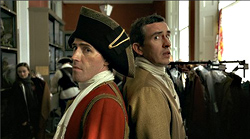A novel almost nobody reads anymore, Lawrence Sterne’s Tristram Shandy was a serially published smash in mid–18th-century England. I’ve read it, and it would take more pages than the entire current issue of SW for me to even attempt a synopsis. So let me introduce Stephen Fry, who plays two roles in this delightfully digressive and faithfully self-reflexive adaptation by Michael Winterbottom, to provide a précis: “Life is chaotic, amorphous. Life is too full, too rich, to be captured by art.” There you have it, class dismissed, everybody gets an A. Sterne’s novel is a kind of burlesque of aristocratic English breeding and manners. It mocks how we’re brought into this muddy, imperfect world, and why. Parental planning goes out the window. All you’re left with is the messy, inexorable, uncertain business of procreation, the organic fullness that defies our best efforts at art and control.
Sterne’s novel begins with the narration of a man (Tristram) before he’s even born. Here, the actor playing both our hero and his father, Walter, is Steve Coogan. Coogan is also a character in the meta-movie, since Winterbottom regularly pulls his camera back to reveal the difficult birthing of this natal comedy. Thus actor Coogan is the new father to a baby with his girlfriend (Kelly Macdonald), yet powerfully attracted to a PA (Naomi Harris); their names are a few vowels apart: Jenny and Jennie, respectively. Is Walter ready to be a father? Is Coogan? Of course not; he just got busted with a lap dancer, which draws tabloid reporters to the set (among them is Tony Wilson, whom Coogan portrayed in Winterbottom’s 24 Hour Party People). Coogan also has testy relations with fellow actor Rob Brydon, who plays Walter’s brother, Toby. Brydon knocks Coogan’s limited range as an actor— comparing him to the ’70s-fossilized Roger Moore. They razz each other about their teeth, paunch, and bald spots, about who’s the leading man of the piece— expert Brit banter honed during their TV work together (including Coogan’s wildly popular Alan Partridge shows, another source of grief to him here).
Meanwhile, PA Jennie knows the novel backward and girlfriend Jenny knows it forward, while clueless Coogan wonders why the book, which he’s never read, doesn’t have an index. His main concern is that Brydon’s heels are too high—making him look short. Then there’s talk among the producers, director (Jeremy Northam), and writer (Ian Hart) about bringing in “a real star,” Gillian Anderson, to help rescue the chaotic production. It’s enough to drive an actor to drink—and perhaps even more lap dancers.
True to the spirit of the novel, Winterbottom regularly interrupts the action and breaks the proscenium, employing flashbacks, freeze frames, split screens, and iris shots to mimic Sterne’s jolly, elbow-nudging, “which reminds me of another story” style of narration. In the book, a straightforward tale gets told, despite itself, in the least straightforward manner possible. It’s an unruly document that lampoons the Age of Enlightenment, a garden that won’t be made topiary, a page that won’t submit to the pen. The novel fights back at its author. Here, Shandy the movie and Shandy the novel are at odds, Brydon and Coogan are amusingly at each other’s throats, and Winterbottom capsizes the very idea of cinematic adaptation—while simultaneously accomplishing that feat—with just what Adaptation was missing: ingenuity, cheekiness, and fun. (R)








